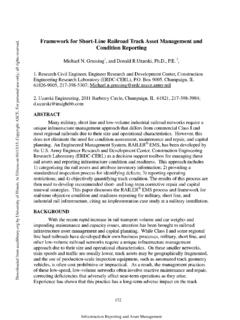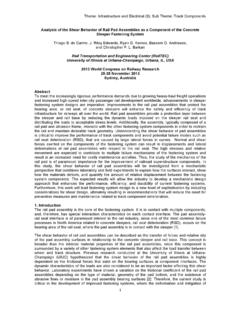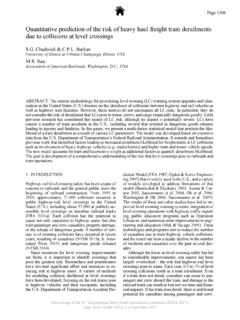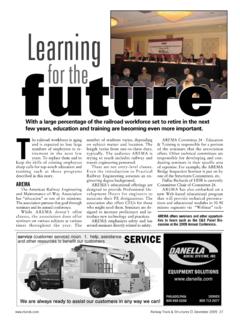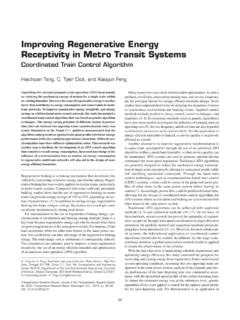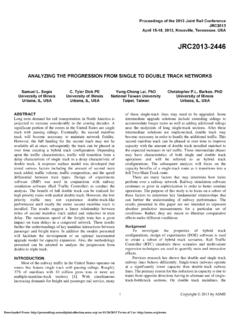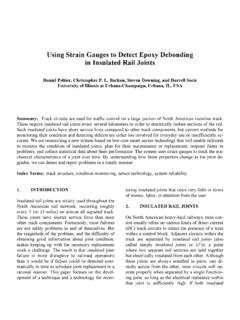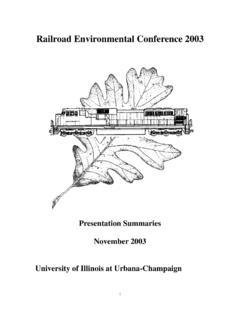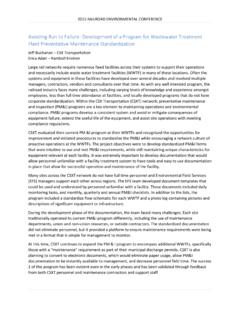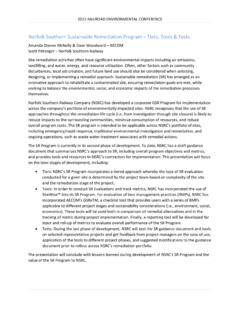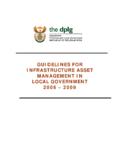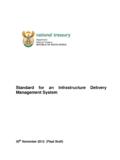Transcription of Development of Prototype Highway Asset …
1 JOURNAL OF INFRASTRUCTURE SYSTEMS / JUNE 1999 /61 Development OFPROTOTYPEHIGHWAYASSETMANAGEMENTSYSTEMB y Nasir G. Gharaibeh,1 Michael I. Darter,2 Member, ASCE,and Donald R. Uzarski,3 Member, ASCEABSTRACT:A Prototype methodology for integrating Highway infrastructure management activities has beendeveloped. This paper describes the analytical procedures and data integration and presentation methods as wellas the geographic information system - (GIS-) based software system that ties together and implements the dataand management procedures. Together these elements comprise the new methodology. There are four majorareas of integration considered in the methodology: (1) Integrated computerized system ; (2) network-level in-tegration; (3) project-level integration; and (4) multiple performance measures.
2 The network-level integrationinvolves performing trade-off analysis to select candidate projects from various Highway infrastructure compo-nents. The project-level integration includes identifying adjacent improvement projects from various infrastruc-ture components that can be implemented simultaneously to reduce traffic disruptions. The project-level inte-gration is performed in a spatial manner using GIS capabilities. The integrated system approach developed inthis study for the management of Highway assets was applied to five infrastructure components (pavements,bridges, culverts, intersections, and signs) of the state Highway system in Champaign County in central sample Highway application showed that coordinating project implementation is beneficial for highwayagencies and users.
3 It reduces disruption to normal traffic flow caused by rehabilitation and reconstructionactivities in a 5-year program by 20%.INTRODUCTIONH ighway agencies are continually investing large sums ofmoney to maintain the physical and operational quality of theirinfrastructure assets above minimum levels. A Highway infra-structure network consists of many components that are nor-mally owned and managed by the same agency ( , pave-ments, bridges, culverts, signs, intersections, and guardrails).Thus, it is logical to expect that managing these componentsin a coordinated manner is beneficial to both users and infrastructure management is essentially a set of ac-tivities associated with the process of maintaining, rehabilitat-ing, and reconstructing/replacing Highway assets in a cost-ef-fective way.
4 Thus, Highway agencies need tools that allowthem to perform coordinated management of their assets andthat provide the services that the community expects of themwithin funding many Highway agencies, separate management systemsare often incompatible in terms of location referencing sys-tems, analytical procedures, and data input/output , data sharing and communication among these systemsbecome impractical and main objective of this research is to provide highwayagencies at the state, county, or municipality with a method-ology for developing tools that can be used to evaluate thetrade-offs among various Highway improvement projects andcoordinate project implementation to reduce traffic other words, this Prototype methodology can be used formanaging various Highway infrastructure components in a co-ordinated and cost-effective manner.
5 The methodology con-sists of analytical procedures and data integration and presen-tation tools, along with the geographic information system -1 Res. Engr., ERES Consultants, Inc., 505 W. University, Champaign,IL 61820. E-mail: ERES Consultants, Inc., 505 W. University, Champaign, Investigator, Army Constr. Engrg. Res. Lab., Champaign,IL Associate Editor: Kenneth Maser. Discussion open until Novem-ber 1, 1999. To extend the closing date one month, a written request mustbe filed with the ASCE Manager of Journals. The manuscript for thispaper was submitted for review and possible publication on May 4, paper is part of theJournal of Infrastructure Systems, Vol. 5, , June, , ISSN 1076-0342/99/0002-0061 0068/$ $.50 per page. Paper No. 18254.(GIS-) based software (called InfraManage) that integrates andimplements those procedures and DESCRIPTIONS ignificant efforts have been made to develop managementsystems to improve efficiency in utilizing limited transporta-tion resources ( , pavement management systems and bridgemanagement systems).
6 However, there has been much lesswork done to develop a total Highway infrastructure man-agement methodology that ties these systems together. Duringthe late 1980s, discussions began on the importance of a com-prehensive system for managing Highway infrastructure com-ponents such as pavements, bridges, culverts, and traffic con-trol devices in a coordinated manner to improve managerialdecisions. However, very few specifics have been stated in of the early efforts in the area of urban infrastructuremanagement was made by the Urban Institute and the Inter-national City management Association in the early 1970s toidentify measures of effectiveness for basic municipal services( , transportation, solid waste collection, water supply, sew-age) (Measuring1974). However, the real-world use of theseeffectiveness measures is still largely untested (Grigg 1988).
7 The need for a total Highway management system and gen-eral guidelines for developing it were discussed by Sinha andFwa (1989). Stephense (1987) described the approach takenby the city of Orlando, Fla., to develop integrated street infra-structure information systems that operate from a commonstreet inventory. Similar systems are used by some municipal-ities to provide performance and inventory information relatedto urban infrastructures , such as pavements, sewers, gas, andelectric (Person and O Day 1986; Zhang et al. 1994; Lee andDeighton 1995). However, most of these systems do not havethe necessary decision support analytical techniques, such aslife cycle cost analysis, utility theory, and optimization tech-niques. These techniques are needed to perform reasonableintegration of engineering as well as economic of the few efforts that established specifics for inte-grating Highway infrastructure management systems is that ofHarper and Majidzadeh (1993) to develop an integrated pave-ment and bridge management system for the kingdom of SaudiArabia using fuzzy set theory to define optimal Finnish National Road Administration coupled bridge andJ.
8 Infrastruct. Syst. from by University of Illinois At Urbana on 02/13/15. Copyright ASCE. For personal use only; all rights JOURNAL OF INFRASTRUCTURE SYSTEMS / JUNE 1999 FIG. 1. system Design for Highway Infrastructure Managementpavement management systems into one infrastructure man-agement system to optimize simultaneously bridge and pave-ment maintenance and rehabilitation activities under a singleset of constraints and budget (Ma nnisto and Tapio 1994).Other valuable efforts to integrate bridge and pavement man-agement systems were made by Ravirala and Grivas (1995)using goal paper describes a Prototype methodology for managingmultiple Highway infrastructure assets in a coordinated andcost-effective manner. Key features of this methodology aresummarized as follows: GIS-based software system Investment trade-offs (network-level integration) Coordination of project implementation (project-level in-tegration)This methodology also considers multiple performancemeasures in the selection of candidate infrastructure improve-ment projects.
9 Spatial and statistical analysis of pavement con-dition, safety, and traffic data conducted on the state highwaysystem in Champaign County, Ill., revealed that the integrationof pavement, safety, and congestion management systems isparticularly critical in urban areas (Gharaibeh et al. 1997).Software SystemAn essential tool for applying the new Highway infrastruc-ture management methodology efficiently is a computer soft-ware system that includes a set of appropriate engineering,economic, and spatial methods, in addition to Highway infra-structure data. This is a GIS-based single system architecturethat includes the combination of various Highway infrastruc-ture Asset management systems. This system incorporates sev-eral tools ( , data, database management functions, analyticalmethods, and information presentation techniques).
10 The poten-tial value of each Highway management system is extendedbeyond its individual scope by allowing engineers and engi-neering managers to coordinate decisions at the planning, man-agement, and operational levels within the Highway InfraManage Prototype GIS-based infrastructure man-agement system is developed to manage five Highway com-ponents (pavements, bridges, culverts, signs, and intersections)in a coordinated manner. The system design and operation pro-cedure of the InfraManage software are summarized in Fig. was developed using version of the ARC/INFO environment, a well-established GIS developed by theEnvironmental Systems Research Institute (Understanding1994). Linear data in InfraManage is designed using the route- system linear data model.
